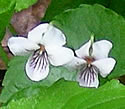Viola renifolia (Kidney-leaved Violet)
| Also known as: | |
|---|---|
| Genus: | Viola |
| Family: | Violaceae (Violet) |
| Life cycle: | perennial |
| Origin: | native |
| Habitat: | part shade, sun; sandy or rocky soil; cool coniferous swamps, floating mats, coniferous and mixed forest, talus slopes, cliffs |
| Bloom season: | April - June |
| Plant height: | 2 to 5 inches |
| Wetland Indicator Status: | GP: FACW MW: FACW NCNE: FACW |
| MN county distribution (click map to enlarge): |  |
| National distribution (click map to enlarge): |  |
Pick an image for a larger view. See the glossary for icon descriptions.
Detailed Information
Flower: 

![[photo of flower]](/udata/r9ndp23q/pd/viola-renifolia-2012-43-t.jpg) Irregular 5-petaled white flower ¼ to ½ inch (to 12 mm) long at the end of a stalk usually held above the leaves at peak bloom. Petals are greenish at the base; the 2 lateral petals usually lack tufts of hair at the base (not bearded) but may be sparsely bearded. The lower petal has numerous dark purple veins radiating from the center, and forms a short spur at the back.
Irregular 5-petaled white flower ¼ to ½ inch (to 12 mm) long at the end of a stalk usually held above the leaves at peak bloom. Petals are greenish at the base; the 2 lateral petals usually lack tufts of hair at the base (not bearded) but may be sparsely bearded. The lower petal has numerous dark purple veins radiating from the center, and forms a short spur at the back.
![[photo of sepals, spur and hairy stalk]](/udata/r9ndp23q/pd/viola-renifolia-2012-1-t.jpg) Sepals are narrowly lance to egg-shaped, blunt at the tip, and hairless. Flower stalks may be hairy or hairless.
Sepals are narrowly lance to egg-shaped, blunt at the tip, and hairless. Flower stalks may be hairy or hairless.
Leaves and stems: 

![[photo of leaves]](/udata/r9ndp23q/pd/viola-renifolia-6354789-5-t.jpg) Leaves are all basal; color is green to gray-green. Mature leaves are up to about 2½ inches (to 62 mm) long, about as wide or wider than long, kidney-shaped to round to broadly egg-shaped with a blunt or rounded tip. Leaf edges are scalloped or have blunt, shallow serrations; one or both surfaces may be densely to sparsely hairy or hairless. Leaf stalks are also densely to sparsely hairy or hairless. Above ground runners (stolons) are absent.
Leaves are all basal; color is green to gray-green. Mature leaves are up to about 2½ inches (to 62 mm) long, about as wide or wider than long, kidney-shaped to round to broadly egg-shaped with a blunt or rounded tip. Leaf edges are scalloped or have blunt, shallow serrations; one or both surfaces may be densely to sparsely hairy or hairless. Leaf stalks are also densely to sparsely hairy or hairless. Above ground runners (stolons) are absent.
Fruit: 
![[photo of fruit]](/udata/r9ndp23q/pd/viola-renifolia-7908-t.jpg) Both petalled (chasmogamous) and petal-less, self-pollinating (cleistogamous) flowers produce fruit, in an ovoid capsule up to 3/8 inch (5 to 10 mm) long, initially green, erect when mature and drying tan with purple splotches. Seeds are light to medium orange-brown or brown, 1.2 to 1.4 mm long.
Both petalled (chasmogamous) and petal-less, self-pollinating (cleistogamous) flowers produce fruit, in an ovoid capsule up to 3/8 inch (5 to 10 mm) long, initially green, erect when mature and drying tan with purple splotches. Seeds are light to medium orange-brown or brown, 1.2 to 1.4 mm long.
Notes:
Kidney-leaved Violet is one of Minnesota's 6+ white violet species, found primarily in cool, shady places, moist or dry, but has most often been recorded in conifer swamps and forests, frequently in rocky soil and on talus slopes. It may be most easily confused with Small White Violet (Viola minuscula, a.k.a. V. macloskeyi), which also inhabits swampy or marshy places. The more rounded leaf tips that give this species the name “kidney-leaved” is something of an indicator but V. minuscula can have a similar shape, and both may have beardless or sparsely bearded flowers. V. minuscula leaves are usually hairless and longer than wide where V. renifolia are usually at least sparsely hairy and as wide as or wider than long. Also, V. renifolia lacks stolons, which are present in other white violets, most notably in summer during cleistagamous flowering and fruit production. V. renifolia has been known to hybridize with some other white violets; hybrids are likely sterile.
Native Plant Nurseries, Restoration and Landscaping Services ↓
More photos
 Kidney-leaved Violet plant
Kidney-leaved Violet plant Kidney-leaved Violet plants
Kidney-leaved Violet plants Kidney-leaved Violet plants
Kidney-leaved Violet plants Kidney-leaved Violet on a talus slope
Kidney-leaved Violet on a talus slope Kidney-leaved Violet on a rocky river bank
Kidney-leaved Violet on a rocky river bank leaves can be densely hairy to hairless or nearly so
leaves can be densely hairy to hairless or nearly so
Photos by K. Chayka taken in Cook County. Photos by Peter M. Dziuk taken in Cook, Pine and Stearns counties.
Comments
Have you seen this plant in Minnesota, or have any other comments about it?
on: 2022-05-16 12:40:05
Deep purple color, kidney shaped leaves with rounded teeth, hairy stems.
on: 2022-05-16 16:24:02
Alicia, Viola renifolia has white flowers, not purple, so you must have seen something else. Post some photos on the Minnesota Wildflowers facebook page if you'd like more help with an ID.
on: 2022-05-28 15:31:37
along the edge of and within a spruce-sphagnum bog, within a half-mile of Big Rice Lake. May be hybridizing with nearby Viola macloskeyi, which I found in a sunnier & grassier location.






